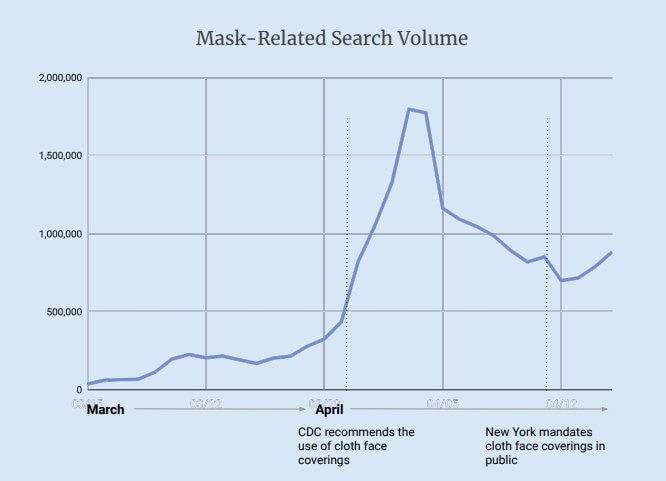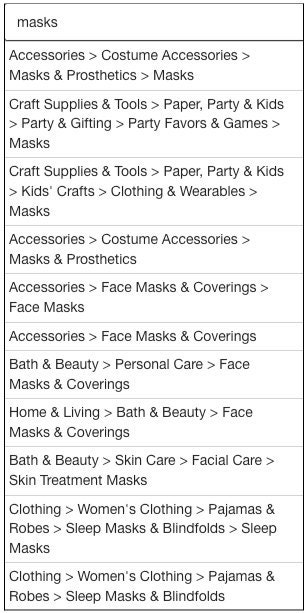
How the 2020 Mask Surge Reshaped Etsy’s Taxonomy Capabilities
On April 3, 2020, the US Centers for Disease Control and Prevention (CDC) recommended wearing face masks in public to combat the spread of the coronavirus. With mass-produced masks in short supply, millions of people turned to Etsy to obtain these newly essential items. (1)
As an online marketplace for handmade and vintage goods, Etsy sells all kinds of masks—sleep masks, skin treatment masks, costume masks, and more—but after the CDC announcement, our buyers were suddenly only interested in face masks and coverings. In order to keep up with demand, which included 6.5 million new buyers in April 2020 alone, Etsy encouraged its sellers to begin making and selling face masks, providing guidance and best practices for listing them on the site safely and within our policies.

The sudden shift in inventory and Etsy’s dramatic spike in traffic presented our engineering organization with many interesting challenges. Teams needed to scale up infrastructure, build new buyer experiences, and support sellers in listing their new items. While these exigencies were felt across the company, this post focuses on the urgent changes that fell to the taxonomy team.
The Etsy Taxonomy
Etsy’s product taxonomy is a hand-curated hierarchy of categories. It is designed to reflect Etsy’s nearly 100 million-item inventory. Every item sold on Etsy is assigned by the seller to a single taxonomy category. The expansiveness of the taxonomy, which currently has 6,500 categories, is a reflection of the vastness of our sellers’ creativity. The taxonomy is foundational and is used across Etsy systems: it shapes category-based buyer experiences, provides inputs to search and machine learning, organizes external reporting, and even affects how products are taxed. Mapping listings to categories makes our listings easier to search and browse and gives us a way of slicing our inventory to understand it better.

Generally, we value stability in our taxonomy. We add new categories only after they have been thoroughly researched, so our taxonomists are sure we are capturing a long-term sector of inventory and not simply chasing trends. Updates to the taxonomy are released about once per month, and we track the growth of newly released categories as sellers begin adding listings to them.
The sudden surge in demand for face masks, however, required us to move a lot faster and with greater urgency than we were used to.
The Face Mask Story
As buyers in large numbers began searching for face masks, and our sellers shifted inventory to meet the demand, we quickly realized we had a problem: Etsy had no taxonomy category for the kind of masks our buyers were looking for! This presented a big hurdle to getting the right kind of mask into shoppers’ carts smoothly and efficiently.

It immediately became our top priority to create a category for face masks and coverings and make it live on the site as fast as possible. This was important for a few reasons:
- Sellers are required to choose a category in order to create a listing, and they did not have an appropriate option. Through no fault of their own, they were assigning face masks and coverings inconsistently to a variety of our existing mask-related categories, such as costume masks.
- Buyers who were urgently seeking face masks and coverings were frustrated and confused when their searches came back populated with irrelevant results.
- We could not collect category-specific metadata about face masks and coverings (number of layers, type of closure, size, equipped with a nose wire or filter, etc.) when they were listed in other categories, so we had no way to help buyers refine their results.
- We could not build a category-specific buyer experience for face masks and coverings on top of a category that did not yet exist.
Introducing a new taxonomy category had never before been a business-critical, time-sensitive process—let alone a process with such significant societal impact. Our established workflow for releasing a new version of the taxonomy—from the time a category was added to our internal taxonomy tool to when it was live on the site—took about two weeks. That included several days for the new category to be translated into all supported languages, for machine learning models to run with the new version, and for search indices to be reindexed against it.
Adding to the challenge was the sheer number of miscategorized face masks and coverings that had been listed before we could take action. Because Etsy believes its sellers know their own products best, we rarely ever override sellers’ chosen categories. Now we had to do a mass recategorization, another unprecedented engineering demand. Taxonomists generated dozens of rules to help accomplish the change, and also relied on keywords, stop words, existing categories, and other indicators to identify listings that belonged in the new face masks and coverings category. The migration itself was done in small batches and impacted over 220,000 listings. Sellers whose listings would be impacted were promptly informed that their listing category had been changed. (This was also the first time that sellers had received communications from Etsy giving them a heads up that a new taxonomy category was coming!)
When the mask rush came, there was no time for our engineers to try to optimize the process. Instead they bore down and looked for whatever manual workarounds they could find to help move things along. Once the new category was live and the migrations complete, engineers turned to optimization and process improvements. Now Etsy is able to implement urgent taxonomy changes with even greater alacrity.
Going Forward
As more people turn to Etsy for various shopping missions, the taxonomy must be able to reflect their needs and desires. Our experience with face masks in April 2020 made our team more responsive, in terms of both process and engineering capabilities. We invested in eliminating the various bottlenecks we encountered with the face mask effort, and we have reaped the benefits.
Today, the process of launching a new taxonomy category on the site has been reduced from two weeks to a matter of hours. We accomplished this by re-architecting how taxonomy data integrates with other systems at Etsy and automating those integration points. The new architecture decouples the taxonomy from non-business-critical functions, resulting in a leaner system. In the course of this work, the engineering team has gained the confidence and built the tools to migrate listings into new, appropriate categories as needed. These automation improvements make large-scale changes less cumbersome, time-consuming, and risky. Our investments ultimately allow us to better meet the needs of our sellers and to continue to provide our buyers with the best possible shopping experience.
(1) - Items sold by Etsy sellers, such as masks, are not medical-grade. Etsy sellers cannot make medical or health claims. When selecting a mask, consult official guidance to make the right choice for you. More info.



